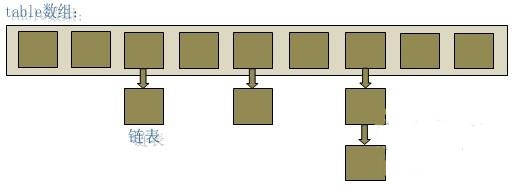在java编程语言中,最基本的结构就是两种,一个是数组,另外一个是模拟指针(引用),所有的数据结构都可以用这两个基本结构来构造的,HashMap也不例外。HashMap实际上是一个“链表散列”的数据结构,即数组和链表的结合体。
自己实现的HashMap代码如下:
package myhashmap;
public class MyHashMap<K, V> {
// initialization capacity
private int capacity = 10;
// total entities
private int size = 0;
// hash表的数组
private Entity<K, V>[] entities = null;
@SuppressWarnings("unchecked")
public MyHashMap() {
entities = new Entity[capacity];
}
public void put(K key, V value) {
if (key == null) {
throw new RuntimeException("The key is null");
}
reHash();
Entity<K, V> newEntity = new Entity<K, V>(key, value);
put(newEntity, this.entities, this.capacity);
}
private void put(Entity<K, V> newEntity, Entity<K, V>[] entities,
int capacity) {
// 实体newEntity要存放在的Entity<K, V>[] entities中的下标
int index = newEntity.getKey().hashCode() % capacity;
Entity<K, V> entity = entities[index];
Entity<K, V> firstEntity = entities[index];
// 如果是第一次放进去元素,直接放入
if (entity == null) {
entities[index] = newEntity;
size++;
} else {
// 这里比较的是 the first entity
// Find the same key for ( the first entity ) ,
// if find then replace the old value to new value
if (newEntity.getKey().equals(entity.getKey())) {
newEntity.setNext(entity.getNext());
newEntity.setPre(entity.getPre());
if (entity.getNext() != null) {
entity.getNext().setPre(newEntity);
}
entities[index] = newEntity;
} else if (entity.getNext() != null) {
// 这里比较的是 all the next entity
// Find the same key for ( all the next entity ),
// if find then replace the old value to new value
while (entity.getNext() != null) {
entity = entity.getNext();
if (newEntity.getKey().equals(entity.getKey())) {
newEntity.setPre(entity.getPre());
newEntity.setNext(entity.getNext());
if (entity.getNext() != null) {
entity.getNext().setPre(newEntity);
}
entities[index] = newEntity;
return;
}
}
// Cannot find the same key, then insert the new entity at the
// header
newEntity.setNext(firstEntity);
newEntity.setPre(firstEntity.getPre());
firstEntity.setPre(newEntity);
entities[index] = newEntity;
size++;
} else {
// Cannot find the same key, then put the new entity in head
newEntity.setNext(firstEntity);
firstEntity.setPre(newEntity);
entities[index] = newEntity;
size++;
}
}
}
public V get(K key) {
if (key == null) {
throw new RuntimeException("The key is null");
}
int index = key.hashCode() % capacity;
Entity<K, V> entity = entities[index];
if (entity != null) {
if (entity.getKey().equals(key)) {
return entity.getValue();
} else {
entity = entity.getNext();
while (entity != null) {
if (entity.getKey().equals(key)) {
return entity.getValue();
}
entity = entity.getNext();
}
}
}
return null;
}
public void remove(K key) {
if (key == null) {
throw new RuntimeException("The key is null");
}
int index = key.hashCode() % capacity;
Entity<K, V> entity = entities[index];
if (entity != null) {
if (entity.getKey().equals(key)) {
if (entity.getNext() != null) {// remove the first entity
entity.getNext().setPre(entity.getPre());
entities[index] = entity.getNext();
entity = null;
} else {// empty this index
entities[index] = null;
}
size--;
} else {
entity = entity.getNext();
while (entity != null) {
if (entity.getKey().equals(key)) {
if (entity.getNext() != null) {
entity.getPre().setNext(entity.getNext());
entity.getNext().setPre(entity.getPre());
entity = null;
} else {
// release the found entity
entity.getPre().setNext(null);
entity = null;
}
size--;
return;
}
entity = entity.getNext();
}
}
}
}
public String toString() {
StringBuilder sb = new StringBuilder();
for (int i = 0; i < capacity; i++) {
sb.append("index=").append(i).append("[");
boolean hasEntity = false;
Entity<K, V> entity = entities[i];
if (entity != null) {
hasEntity = true;
}
while (entity != null) {
sb.append("[").append(entity.getKey()).append("=")
.append(entity.getValue()).append("]").append(",");
entity = entity.getNext();
}
if (hasEntity) {
sb.deleteCharAt(sb.length() - 1);
}
sb.append("]\n");
}
return sb.toString();
}
/**
* Simple re-hash strategy, if the size is bigger than capacity, then do
* re-hash action
*/
private void reHash() {
if (size >= capacity) {
int newCapacity = capacity * 2;
@SuppressWarnings("unchecked")
Entity<K, V>[] newEntities = new Entity[newCapacity];
for (int i = 0; i < capacity; i++) {
Entity<K, V> entity = entities[i];
while (entity != null) {
put(entity, newEntities, newCapacity);
entity = entity.getNext();
}
}
this.capacity = newCapacity;
this.entities = newEntities;
}
}
public static void main(String[] args) {
MyHashMap<String, String> map = new MyHashMap<String, String>();
map.put("one", "1");
map.put("two", "2");
map.put("three", "3");
map.put("four", "4");
map.put("five", "5");
map.put("six", "6");
map.put("seven", "7");
map.put("eight", "8");
map.put("nine", "9");
map.put("ten", "10");
System.out.println(map.get("one"));
System.out.println(map.get("two"));
System.out.println(map.get("three"));
System.out.println(map.get("four"));
System.out.println(map.get("five"));
System.out.println(map.get("six"));
System.out.println(map.get("seven"));
System.out.println(map.get("eight"));
System.out.println(map.get("nine"));
System.out.println(map.get("ten"));
System.out.println(map.toString());
map.remove("nine");
map.remove("three");
System.out.println(map.get("one"));
System.out.println(map.get("two"));
System.out.println(map.get("three"));
System.out.println(map.get("four"));
System.out.println(map.get("five"));
System.out.println(map.get("six"));
System.out.println(map.get("seven"));
System.out.println(map.get("eight"));
System.out.println(map.get("nine"));
System.out.println(map.get("ten"));
System.out.println(map.toString());
}
}
class Entity<K, V> {
private K key;
private V value;
private Entity<K, V> pre;
private Entity<K, V> next;
public Entity(K key, V value) {
this.key = key;
this.value = value;
}
public K getKey() {
return key;
}
public void setKey(K key) {
this.key = key;
}
public V getValue() {
return value;
}
public void setValue(V value) {
this.value = value;
}
public Entity<K, V> getPre() {
return pre;
}
public void setPre(Entity<K, V> pre) {
this.pre = pre;
}
public Entity<K, V> getNext() {
return next;
}
public void setNext(Entity<K, V> next) {
this.next = next;
}
}2、原博客地址
http://blog.csdn.net/fenglibing/article/details/14166011























 4660
4660

 被折叠的 条评论
为什么被折叠?
被折叠的 条评论
为什么被折叠?








